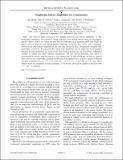| dc.contributor.author | Tackmann, Frank J. | |
| dc.contributor.author | Waalewijn, Wouter J. | |
| dc.contributor.author | Moult, Ian James | |
| dc.contributor.author | Stewart, Iain | |
| dc.date.accessioned | 2016-05-04T17:22:20Z | |
| dc.date.available | 2016-05-04T17:22:20Z | |
| dc.date.issued | 2016-05 | |
| dc.date.submitted | 2015-09 | |
| dc.identifier.issn | 2470-0010 | |
| dc.identifier.issn | 2470-0029 | |
| dc.identifier.uri | http://hdl.handle.net/1721.1/102403 | |
| dc.description.abstract | Many state-of-the-art QCD calculations for multileg processes use helicity amplitudes as their fundamental ingredients. We construct a simple and easy-to-use helicity operator basis in soft-collinear effective theory (SCET), for which the hard Wilson coefficients from matching QCD onto SCET are directly given in terms of color-ordered helicity amplitudes. Using this basis allows one to seamlessly combine fixed-order helicity amplitudes at any order they are known with a resummation of higher-order logarithmic corrections. In particular, the virtual loop amplitudes can be employed in factorization theorems to make predictions for exclusive jet cross sections without the use of numerical subtraction schemes to handle real-virtual infrared cancellations. We also discuss matching onto SCET in renormalization schemes with helicities in 4- and d-dimensions. To demonstrate that our helicity operator basis is easy to use, we provide an explicit construction of the operator basis, as well as results for the hard matching coefficients, for pp → H + 0, 1, 2 jets, pp → W/Z/γ + 0, 1, 2 jets, and pp → 2, 3 jets. These operator bases are completely crossing symmetric, so the results can easily be applied to processes with e[superscript +]e[superscript -] and e[superscript -]p collisions. | en_US |
| dc.description.sponsorship | United States. Dept. of Energy (Contract DE-SC0011090) | en_US |
| dc.description.sponsorship | Deutsche Forschungsgemeinschaft (Emmy-Noether Grant TA 867/1-1) | en_US |
| dc.description.sponsorship | Marie Curie International Incoming Fellowship (PIIF-GA-2012-328913) | en_US |
| dc.description.sponsorship | Simons Foundation (Investigator Grant 327942) | en_US |
| dc.description.sponsorship | Natural Sciences and Engineering Research Council of Canada | en_US |
| dc.description.sponsorship | D-ITP Consortium | en_US |
| dc.publisher | American Physical Society | en_US |
| dc.relation.isversionof | http://dx.doi.org/10.1103/PhysRevD.93.094003 | en_US |
| dc.rights | Article is made available in accordance with the publisher's policy and may be subject to US copyright law. Please refer to the publisher's site for terms of use. | en_US |
| dc.source | American Physical Society | en_US |
| dc.title | Employing helicity amplitudes for resummation | en_US |
| dc.type | Article | en_US |
| dc.identifier.citation | Moult, Ian, Iain W. Stewart, Frank J. Tackmann, and Wouter J. Waalewijn. “Employing Helicity Amplitudes for Resummation.” Phys. Rev. D 93, no. 9 (May 3, 2016). © 2016 American Physical Society | en_US |
| dc.contributor.department | Massachusetts Institute of Technology. Center for Theoretical Physics | en_US |
| dc.contributor.department | Massachusetts Institute of Technology. Department of Physics | en_US |
| dc.contributor.mitauthor | Moult, Ian James | en_US |
| dc.contributor.mitauthor | Stewart, Iain | en_US |
| dc.relation.journal | Physical Review D | en_US |
| dc.eprint.version | Final published version | en_US |
| dc.type.uri | http://purl.org/eprint/type/JournalArticle | en_US |
| eprint.status | http://purl.org/eprint/status/PeerReviewed | en_US |
| dc.date.updated | 2016-05-03T22:00:06Z | |
| dc.language.rfc3066 | en | |
| dc.rights.holder | American Physical Society | |
| dspace.orderedauthors | Moult, Ian; Stewart, Iain W.; Tackmann, Frank J.; Waalewijn, Wouter J. | en_US |
| dc.identifier.orcid | https://orcid.org/0000-0002-4819-4081 | |
| dc.identifier.orcid | https://orcid.org/0000-0003-0248-0979 | |
| mit.license | PUBLISHER_POLICY | en_US |
